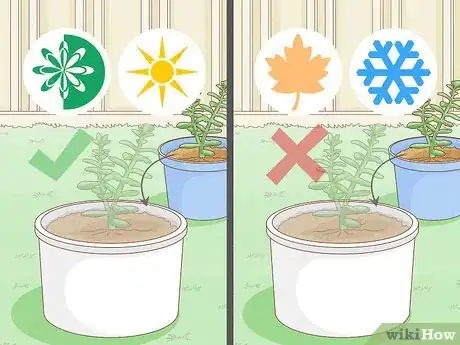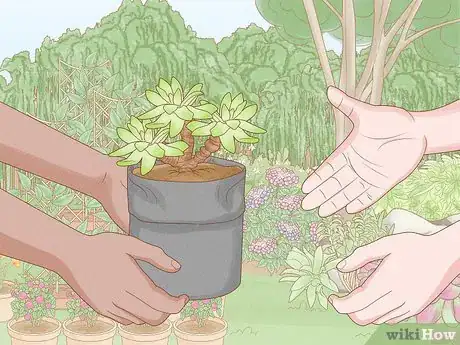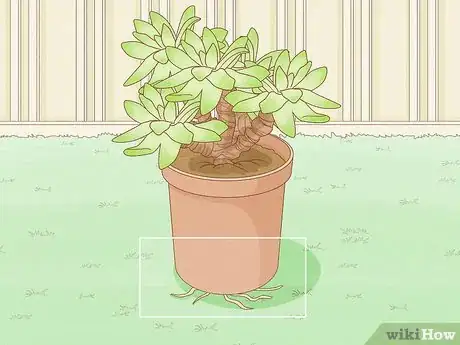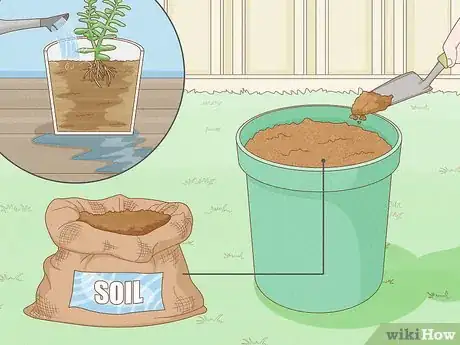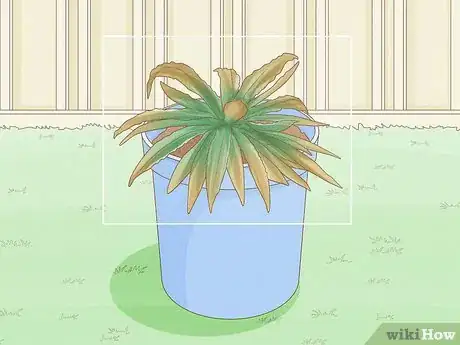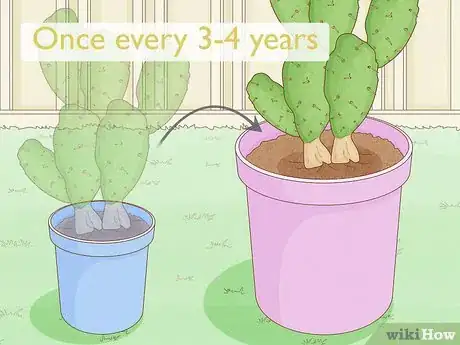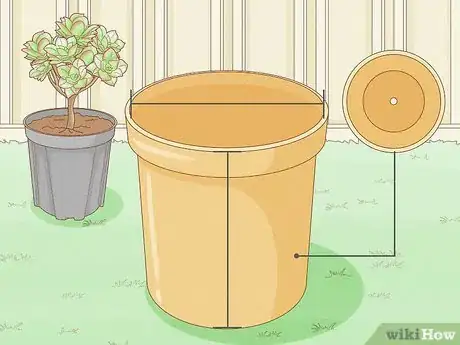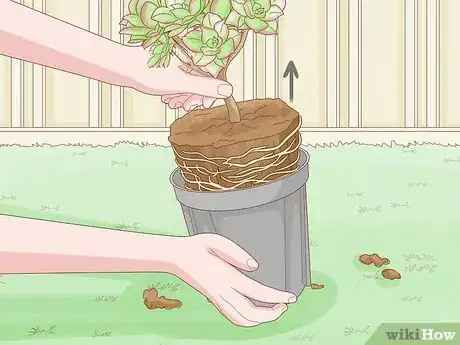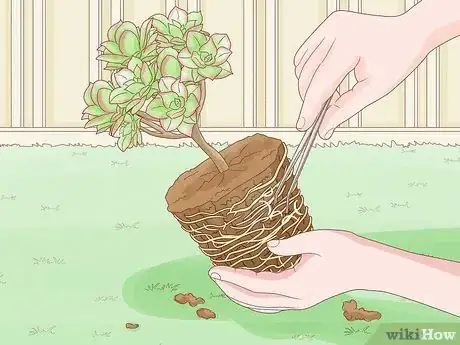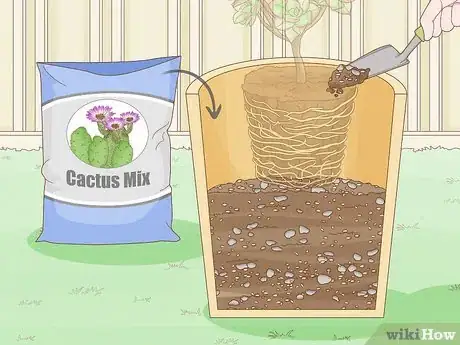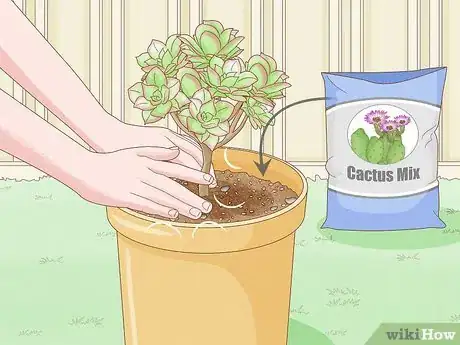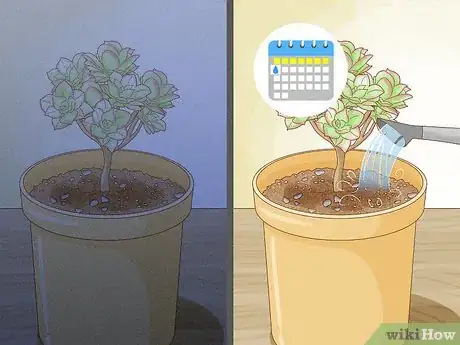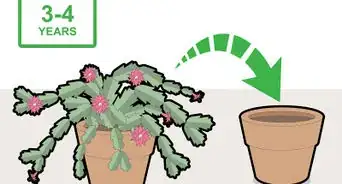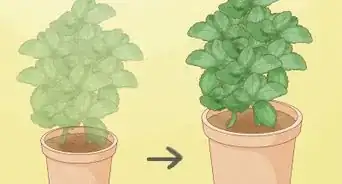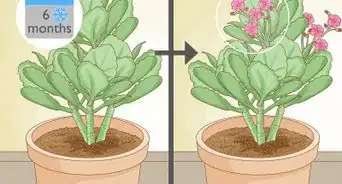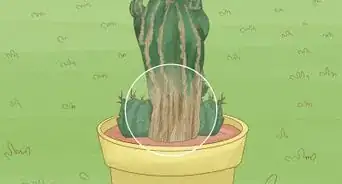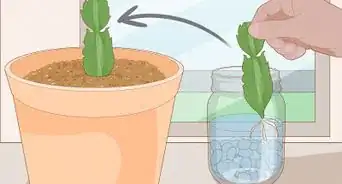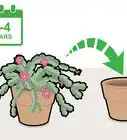This article was co-authored by Rachel Guffey and by wikiHow staff writer, Janice Tieperman. Rachel Guffey is a Plant Specialist and the Owner of Jungle House, a house plant shop based in Lawrence, Kansas. She specializes in plant education and caring for indoor plants. Rachel is passionate about using plants to help combat seasonal depression. She aims to make plants feel more accessible and approachable to everyone. Rachel has owned over 500 plants at one time.
There are 13 references cited in this article, which can be found at the bottom of the page.
This article has been viewed 27,410 times.
All succulents need to be repotted at one point another, whether they’re newly purchased or a token part of your home decor. But how can you safely re-house your succulent without hurting it in the process? You’ve come to the right place. We’re outlined the best, most essential times to repot your succulents, along with helpful advice on how to repot your succulents the right way. In a matter of minutes, your beautiful plants will be safe and secure in their new potted homes.
Steps
When to Repot a Succulent
-
1In warm weather during the active growing season. Succulents are actively growing in the spring and summer months, which makes this time of year really great for repotting. Once transplanted, the developing roots can settle into the new pot nicely.[1]
- Succulents are dormant between the fall and winter months, so it’s not a good idea to repot your succulent then.
-
2You just bought it from a store or nursery. Most store-bought plants come in really small nursery pots, which don’t provide nearly enough space for your succulent to grow and thrive. An upgrade is in order to keep your plant happy and healthy.[2]Advertisement
-
3
-
4The old soil doesn’t retain water well. A succulent needs more water as it continues to grow, and eventually, its current pot just won’t cut it. Rapidly draining soil shows that a plant is drinking up the water much more quickly, and that it needs a bigger pot.[5]
-
5Your succulent looks like it’s wilting or dying. Repotting is a great way to breathe some new life into your plant, and is an excellent solution when your succulent looks to be on its last legs.[6]
- Make sure that you’ve ruled out any other causes of your plant’s droopy appearance, though. Too much or too little water can leave a succulent drooping, as well as low light. Try changing up your plant’s weekly care routine first and see if anything improves.[7]
-
6
Repotting a Succulent
-
1Choose a slightly roomier, well-draining pot for your succulent. Repotting is all about giving your succulent an upgrade so it has plenty of room to stretch and grow its roots. Your new pot doesn’t have to be massive, but it should look a little bit wider and deeper than your succulent’s current planter. Check that the new pot has at least 1 drainage hole at the bottom, so water doesn’t collect at the base.[10]
- Drainage holes help extra water filter out of the plant instead of collecting at the bottom. If the water can’t drain properly, your succulent may develop root rot.[11]
-
2Remove the old succulent gently from its pot or planter. Place the current succulent pot on its side and wrap a soft cloth loosely around the thickest part of the stem if the plant is prickly or spiny. Then, very gently pull and coax the succulent out of its pot.[12]
- If the succulent is smooth, gently pull it out of the pot with your bare hands.[13]
-
3Separate the roots with a pair of garden tweezers. The root ball, or the bottom of the plant, is probably tangled a bit clumped together. Poke your tweezers into the soil a few times to loosen up some of these roots, so they have an easier time growing into the new pot and soil.[14]
- You can also use a fork to separate any tangled or compacted roots.
-
4
-
5Set your displaced succulent in the pot and cover its roots with more cactus mix. Check that the succulent is centered, and gently scoop spoonfuls of cactus mix on top of the root system. Completely cover the roots with the mix, filling up the pot so the soil is just below the rim. Then, press down the edges of the soil so you fit a little more soil in your pot.[20]
- If your succulent is especially prickly, like a cactus, use a wooden rod or another long object to press the soil down.
-
6Wait at least 1 week to water your repotted succulent. Your succulent’s roots are banged up from being repotted and need time to recover completely. After a week or so, water your succulent as you normally would.[21]
- Keep your succulent in a dark spot while it heals.
Community Q&A
-
QuestionIs it appropriate to cut down the roots?
 wikiHow Staff EditorThis answer was written by one of our trained team of researchers who validated it for accuracy and comprehensiveness.
wikiHow Staff EditorThis answer was written by one of our trained team of researchers who validated it for accuracy and comprehensiveness.
Staff Answer wikiHow Staff EditorStaff AnswerYou don't actually need to cut down the roots! Repotting your succulent involves moving it to a larger pot that has enough room for all of the roots.
wikiHow Staff EditorStaff AnswerYou don't actually need to cut down the roots! Repotting your succulent involves moving it to a larger pot that has enough room for all of the roots. -
QuestionI have 4 small succulents bought at Lowe’s. The soil is dry, and I'm getting ready to repot. The soil I have is damp... should I water before potting or after or neither?
 wikiHow Staff EditorThis answer was written by one of our trained team of researchers who validated it for accuracy and comprehensiveness.
wikiHow Staff EditorThis answer was written by one of our trained team of researchers who validated it for accuracy and comprehensiveness.
Staff Answer wikiHow Staff EditorStaff AnswerWait at least a week to water after repotting your succulents! This gives your roots time to heal after they're repotted.
wikiHow Staff EditorStaff AnswerWait at least a week to water after repotting your succulents! This gives your roots time to heal after they're repotted.
Warnings
- Never stick lots of rocks or clay pieces at the bottom of your succulent pot. Despite popular belief, these won’t help with drainage–they just cramp your plant.[23]⧼thumbs_response⧽
Things You’ll Need
Repotting a Succulent
- Pot (with drainage holes)
- Water
- Garden tweezers
- Cactus mix
- Trowel or spoon
References
- ↑ https://libguides.nybg.org/succulents
- ↑ https://www.gearpatrol.com/home/a739198/how-to-repot-a-plant/#
- ↑ https://www.bbc.co.uk/gardening/basics/techniques/houseplants_cactus1.shtml
- ↑ https://www.bobvila.com/articles/when-to-repot-a-plant/
- ↑ https://www.bobvila.com/articles/when-to-repot-a-plant/
- ↑ https://www.bobvila.com/articles/when-to-repot-a-plant/
- ↑ https://www.gardenersworld.com/how-to/grow-plants/how-to-grow-aloe-vera/
- ↑ https://www.gardenersworld.com/how-to/grow-plants/how-to-grow-succulents/
- ↑ https://www.gardenersworld.com/how-to/grow-plants/how-to-repot-a-cactus/
- ↑ https://ucanr.edu/blogs/blogcore/postdetail.cfm?postnum=16218
- ↑ https://gardeningsolutions.ifas.ufl.edu/plants/ornamentals/succulents.html
- ↑ https://www.gardenersworld.com/how-to/grow-plants/how-to-repot-a-cactus/
- ↑ https://ucanr.edu/blogs/blogcore/postdetail.cfm?postnum=16218
- ↑ https://www.youtube.com/watch?v=KP9JiyN6QeY&t=1m6s
- ↑ https://www.gardenersworld.com/how-to/grow-plants/how-to-repot-a-cactus/
- ↑ https://www.youtube.com/watch?v=KP9JiyN6QeY&t=1m36s
- ↑ https://extension.umn.edu/houseplants/cacti-and-succulents#potting-mix-1421911
- ↑ https://ucanr.edu/blogs/blogcore/postdetail.cfm?postnum=16218
- ↑ https://extension.umn.edu/houseplants/cacti-and-succulents#potting-mix-1421911
- ↑ https://www.youtube.com/watch?v=KP9JiyN6QeY&t=1m55s
- ↑ https://ucanr.edu/blogs/blogcore/postdetail.cfm?postnum=16218
- ↑ https://ucanr.edu/blogs/blogcore/postdetail.cfm?postnum=16218
- ↑ https://ucanr.edu/blogs/blogcore/postdetail.cfm?postnum=16218
